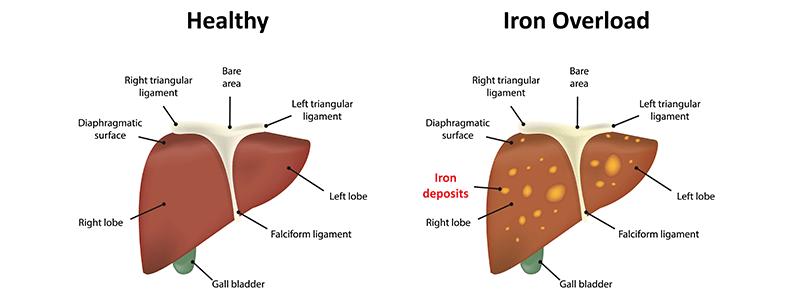Juvenile hemochromatosis (ju·ve·nile - he·mo·chro·ma·to·sis) is a condition that is present at birth (congenital), but is typically not diagnosed until later in life. Hemochromatosis is, however, sometimes diagnosed between the ages of 15 and 30. This is known as juvenile hemochromatosis.
Overview
What is juvenile hemochromatosis?
Hemochromatosis is an inherited condition that causes the body to absorb too much iron from foods.

Signs and Symptoms
What are the signs and symptoms of juvenile hemochromatosis?
Early symptoms
Fatigue
Pain in the abdomen
Pain in the joints
Weakness
Later symptoms
Problems with sexual function
Diagnosis
How is juvenile hemochromatosis diagnosed?
Hemochromatosis is a condition that is present at birth (congenital), but is typically not diagnosed until later in life – generally around age 50 or 60. Hemochromatosis is, however, sometimes diagnosed between the ages of 15 and 30. This is known as juvenile hemochromatosis.
In a person with this condition, the body absorbs too much iron from foods. In turn, that extra iron is stored in the organs, including the liver, heart and pancreas. Extra iron in these organs can cause serious problems, such as liver disease, heart problems and diabetes.
Causes
What are the causes of juvenile hemochromatosis?
Hemochromatosis is hereditary (passed down in families) through a mutated gene.
Doctors and Providers
 Amal Ahmad AqulPediatric Hepatologist
Amal Ahmad AqulPediatric Hepatologist Megha Satish MehtaPediatric Gastroenterologist
Megha Satish MehtaPediatric Gastroenterologist Charina Marie RamirezPediatric Gastroenterologist
Charina Marie RamirezPediatric Gastroenterologist Norberto Rodriguez BaezPediatric Hepatologist
Norberto Rodriguez BaezPediatric Hepatologist Isabel Cristina Rojas SantamariaPediatric Gastroenterologist
Isabel Cristina Rojas SantamariaPediatric Gastroenterologist Phuong LuuPhysician Assistant - Gastroenterology
Phuong LuuPhysician Assistant - Gastroenterology To Nhu Thuy NguyenPhysician Assistant - Gastroenterology
To Nhu Thuy NguyenPhysician Assistant - Gastroenterology Jennifer Kate PeacockNurse Practitioner - Gastroenterology
Jennifer Kate PeacockNurse Practitioner - Gastroenterology Shabina Walji ViraniNurse Practitioner - Gastroenterology
Shabina Walji ViraniNurse Practitioner - Gastroenterology